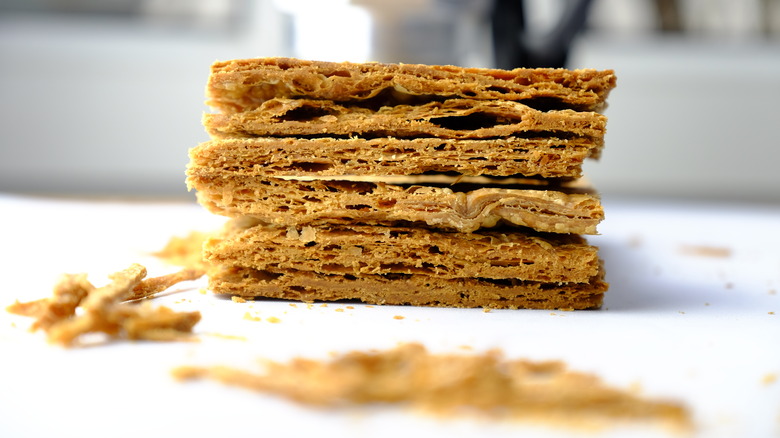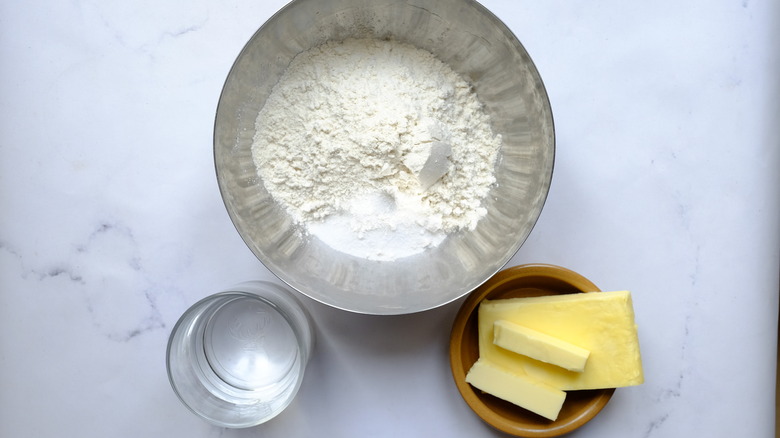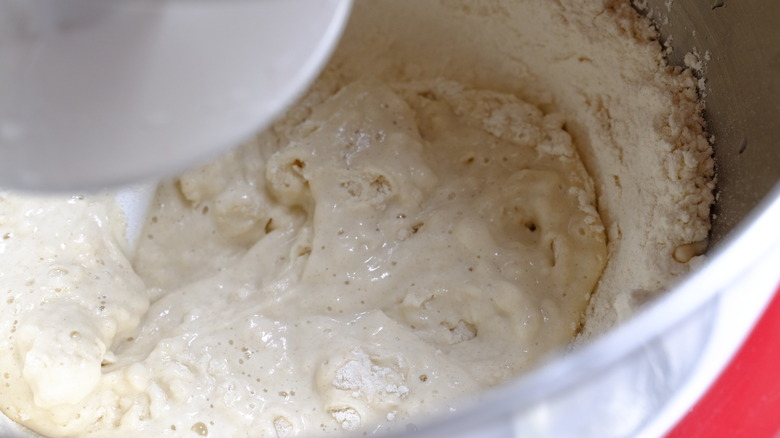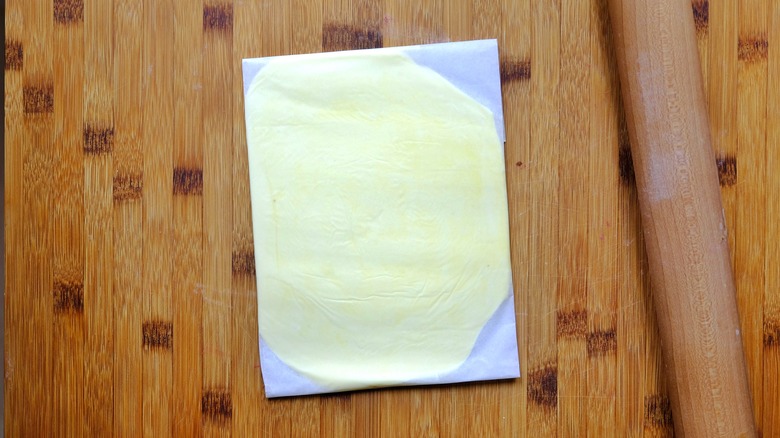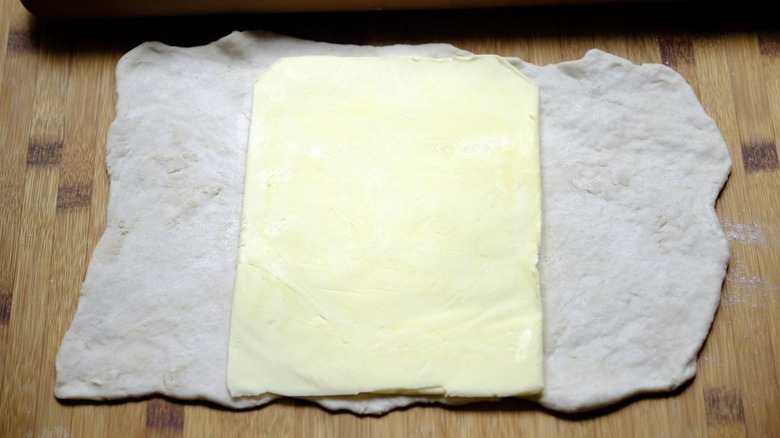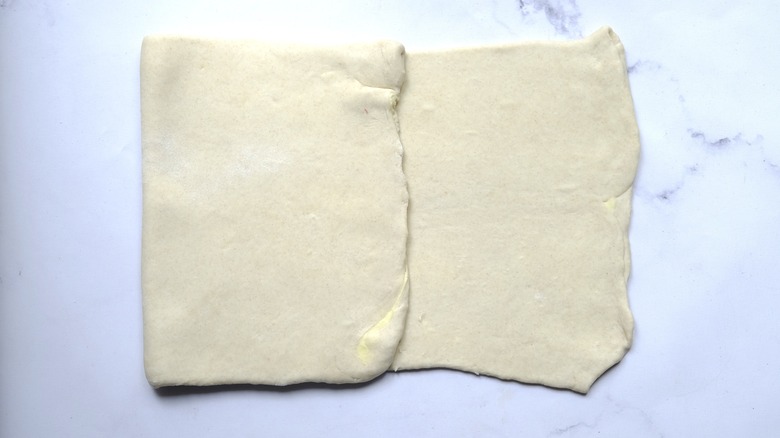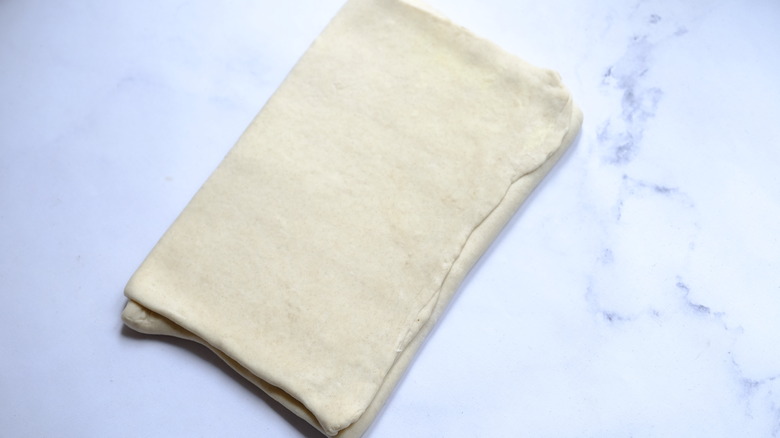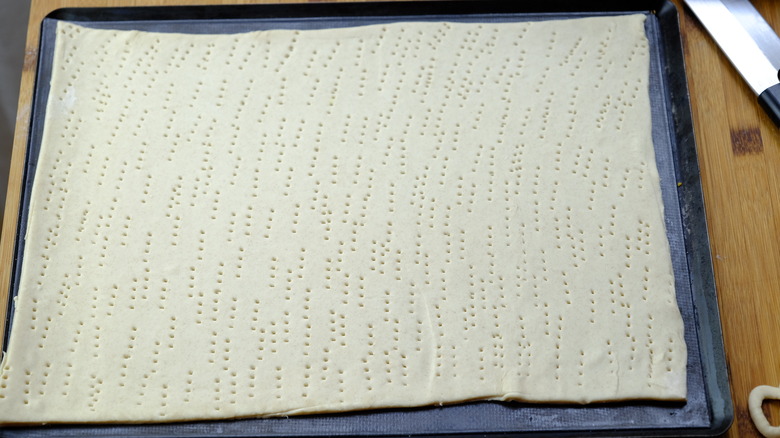Homemade Puff Pastry Recipe
Puff pastry, an extraordinarily tender and flaky type of pastry, is a beautiful thing to have in your kitchen, as chef and recipe developer Eric Ngo explained to Mashed. Of course, the same can be said of regular pie dough, but what makes puff pastry dough so unique is that it is built through a process known as "lamination." According to Ngo, lamination is a dough-making process by which the butter is laid atop dough and then folded in. The result is alternating micro-layers of dough and butter that will result in a supremely flaky and delicious pastry.
Whereas you could potentially make pie dough in a food processor and no one would be the wiser, puff pastry is more demanding. That's because the butter must be folded into the puff pastry by hand in order to properly achieve its lovely layered result. While it may not be the easiest baking task you've ever done, it is well worth the effort because not only is the result exquisite, but the process is illuminating. If you really want to wow people with your culinary skills, puff pastry is a great tactic to have in your baking arsenal.
Just remember to work efficiently and rely on your fridge. "Puff pastry is a great recipe to work quickly and efficiently because of how quickly butter melts," Ngo says. "Making puff pastry also requires skill in using a rolling pin." So, let's build some skills while we build some tasty pastry.
Gather your ingredients for puff pastry
Chef Ngo had to go all the way to culinary school in Paris to learn the techniques he is about to share with you via this recipe for puff pastry. But all you'll have to do, you lucky intrepid home cook, you, is to gather up four simple ingredients and follow along.
First, you'll need two cups of all-purpose flour, ½ teaspoon of salt, and ½ cup of water (extra credit if you weigh the water on a scale, in which case you're looking for 4.2 ounces). These three ingredients will form the dough base onto which you will then layer 1 ¼ sticks of European-style butter. Please note that the butter should be cold when you start working with it, so don't let it sit out on the counter.
In terms of supplies, you'll also need plastic wrap, parchment paper, a stand mixer with a dough hook attachment, and a rolling pin.
Form your dough base
Place the flour, water, and salt in a stand mixer bowl with the pastry hook attachment in place. Mix these ingredients for 5 minutes on medium speed to form the dough base. Remember that, at this point, the mixture is purposefully fat-free, as we'll begin the process of adding the butter in just a few minutes. Also, remember that the butter needs to be cold, so it should be chilling out in the refrigerator at this point.
When the dough has come together — be careful not to overmix it — take it out of the bowl and form it into a thick, medium-sized disk. Cover the disk in plastic wrap and place it in the freezer for 15 minutes.
Now, let's turn to the butter
While the dough base is chilling, rip off a big piece of parchment paper. How big, you might be wondering? Big enough so that you can form a 6x10-inch rectangle after folding the piece in half. Place your butter into the center of the rectangle. Using your rolling pin, roll out the butter to fill the 6x10-inch shape you formed by folding over the parchment paper.
Place the flattened butter into the refrigerator to keep it cold while you move on to the next step.
Begin laminating the dough
First, lightly flour your work surface. Take the dough out of the freezer and place it on the floured work surface. Then, using your rolling pin, roll out the dough so that it is about double the size of your butter rectangle.
Now, take the butter rectangle out of the refrigerator. At this stage, it should be cold but still flexible. If it's a little too hard to be workable, give the butter a minute to sit at room temperature and check it again. When it's ready, lay the butter on top of the rolled-out dough. Move immediately onto the next step, as you don't want to give the butter a chance to start melting.
As you may have already guessed, speed and efficiency seriously count when making puff pastry. However, there's no need to stress out. As Ngo says, "practice makes progress."
Fold the dough over the butter and roll it out
With the butter on top of the dough, fold the dough over it so that the butter is completely enclosed. You will fold the dough from the outsides toward the center.
Then, using your rolling pin, roll out this dough and butter package into a rectangular sheet measuring 6x10 inches. If you could use a bit of help getting the dimensions just right, Ngo recommends measuring the length of your rolling pin first, and then using your rolling pin as a "ruler" to measure the sides of your dough. And, of course, you can always use a regular ruler (that you've washed first, naturally).
Fold your dough, roll it out, chill, then repeat
Fold the sheet of dough into thirds by taking the right-hand side of the dough and flipping it over to overlap ⅓ of the dough sheet, and then flipping the left-hand side over that. Even though you're technically folding the dough over twice, the process of folding the dough into thirds is referred to as making a single "fold."
Place the folded dough into the refrigerator (not the freezer) for 10 minutes to cool down. This will help to keep the butter from melting, which will eventually lead to a beautifully flaky final pastry, so don't skip the fridge time. After 10 minutes, take the dough out of the refrigerator and place it on your work surface once again. Said surface should still have flour on it, but if not, sprinkle a bit more flour on top to prevent sticking.
Roll the dough out into a 24 x 8-inch rectangle. Ngo recommends shifting the dough every 30 seconds or so, which will help further ensure that it does not stick to your work space. Make another fold and chill the fridge for 10 minutes. Repeat this process four more times for a total of five folds.
Bake your puff pastry
First, preheat your oven to 350 F. Lay another large piece of parchment paper on your work surface and lightly flour it. When your oven has fully preheated, place the dough onto the parchment. Roll it out to a thickness of two to three millimeters, or about ⅒ inch. Pick up the parchment and turn it over onto a large baking sheet, and poke it numerous times with a fork. This allows for an even rise while baking, according to Ngo).
Now, if it happens that you're already pretty experienced with pastry dough or are feeling confident, you can use the method that professional pastry chefs like Ngo prefer: Gently drape the dough over your rolling pin and transfer it to your baking sheet. You'll not only look like a boss, but you'll also save a sheet of parchment paper, too.
Bake the puff pastry dough for 35 minutes. Take it out of the oven, and allow it to cool for 15 minutes. Trim to the size you wish, depending on what you will be using it for. Puff pastry dough is excellent for any number of things from breakfast to dessert, says Ngo. "Puff pastry is used to make various desserts such as apple tart, mille feuille, and flan. It can also be used in savory dishes." Really, the only baking limit here is your imagination.
Homemade Puff Pastry Recipe
If you really want to wow people with your culinary skills, puff pastry is a great tactic to have in your baking arsenal. Here's how to make it in your kitchen.
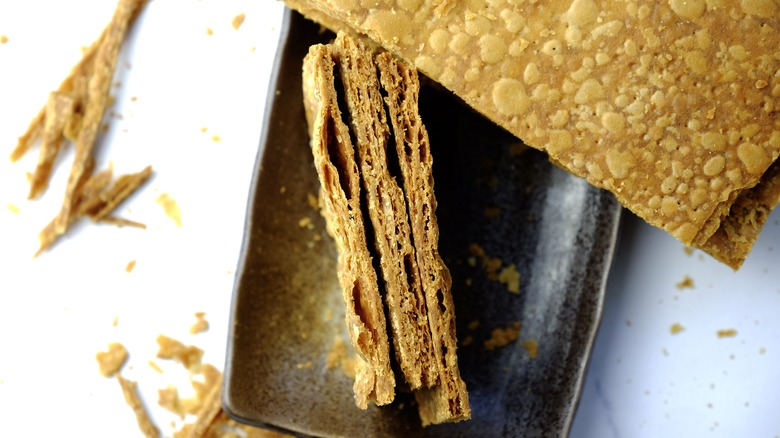
Ingredients
- 2 cups all-purpose flour
- ½ cup water
- 1 ¼ sticks European style butter
- ½ teaspoon salt
Directions
- Combine flour, water, and salt in the bowl of a stand mixer. Using the hook attachment, mix on medium speed, for 5 minutes.
- Take the dough from the bowl and flatten it into a disk. Wrap the disk in plastic and place it in the freezer for 15 minutes.
- Fold over the edges of a piece of parchment paper to form a 6 x 10-inch rectangle. Put the butter into the center. Fold the parchment paper over the butter.
- Roll the butter into a rectangular shape, using the parchment paper as your template. Place butter in the refrigerator.
- Lightly flour your work surface. Take the dough out of the freezer and roll it out to double the size of the butter.
- Take the butter out of the freezer and center it on the sheet of dough. Fold the dough towards the center to enclose the butter.
- Roll out the dough and butter packet to a 24 x 8-inch rectangle. Fold the rectangle into thirds.
- Chill the dough in the refrigerator for 10 minutes.
- Remove the chilled dough and roll out to 24 x 8 inches.
- Chill, roll, and repeat fold for a total of 5 folds. Place the dough back into the refrigerator.
- Preheat oven to 350 F.
- When your oven has fully preheated, take out the dough and roll it out to about ⅒ inch, or 2 to 3 millimeters.
- Transfer the dough to your baking sheet. Poke the dough repeatedly with a fork.
- Bake for 35 minutes.
- Take the pastry out the over and allow to cool for 15 minutes.
- Trim the cooked pastry to the desired size.
Nutrition
| Calories per Serving | 240 |
| Total Fat | 14.6 g |
| Saturated Fat | 9.1 g |
| Trans Fat | 0.6 g |
| Cholesterol | 38.0 mg |
| Total Carbohydrates | 23.9 g |
| Dietary Fiber | 0.8 g |
| Total Sugars | 0.1 g |
| Sodium | 148.2 mg |
| Protein | 3.4 g |
